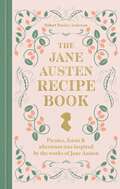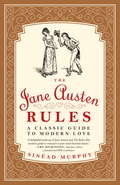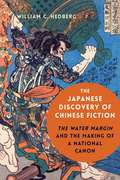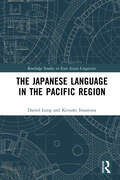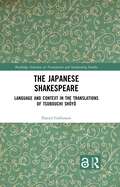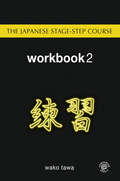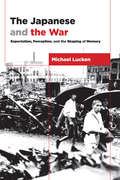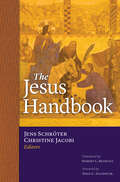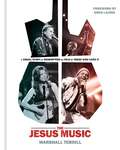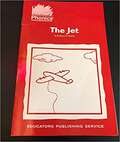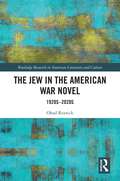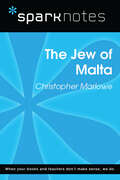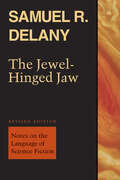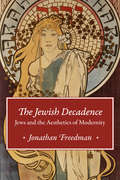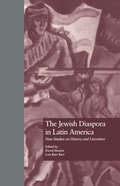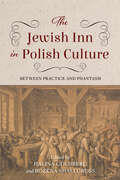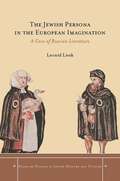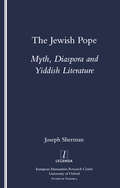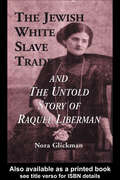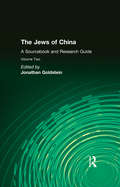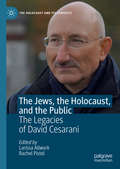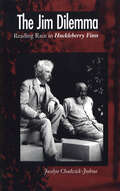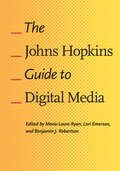- Table View
- List View
The Jane Austen Recipe Book: Picnics, Feasts and Afternoon Teas Inspired by Jane Austen
by Robert Tuesley AndersonThe novels of Jane Austen are full of great feasting, from picnicking on Box Hill and strawberry picking at Donwell Abbey in Emma, to supper at the Netherfield Ball and Mrs. Bennet's sumptuous family dinners in Pride and Prejudice. The Jane Austen Recipe Book takes inspiration from the celebrated author's works and serves up over 70 of these delicious Regency era delights for you to recreate at home.Explore a wide range of Austen-inspired recipes from Lady Catherine de Bourgh's Caraway and Raisin Breakfast Bread to Elizabeth Martin's Sausage Rolls, Mansfield Wood Roast Pheasant and Mr Woodhouse's 'All-Apple' Tarts, this beautiful collection takes you through the day from breakfast to dinner, crafting fabulous foods to be enjoyed with friends around a well-laid table.Featuring delicious, easy-to-follow recipes alongside fascinating insights into the world of Jane Austen's novels and Regency era England, The Jane Austen Recipe Book makes a wonderful addition to the bookshelf of Austen fans and anyone with a keen interest in eighteenth and nineteenth century feasting.· Featuring a wide variety of delicious foods inspired by the novels of Jane Austen, with clear steps to help you recreate them in your own kitchen.· Indulge in the luxury and splendour of the Regency period with food and drink perfect for every occasion - from breakfasts and dinners to picnics, luncheons and puddings.· Immerse yourself in Austen's world with detailed notes and essays providing insight into the world of eighteenth century living and the works of Jane Austen.
The Jane Austen Rules
by Sinead MurphyWhat Would Jane Do?What's a strong, independent-minded woman supposed to do in a world of insipid dating guides? Sinéad Murphy responds by asking: Who has more time-tested secrets than Jane Austen, whose novels continue to captivate us almost two hundred years later?Whether you can recite paragraphs from Pride and Prejudice or just admired Colin Firth in his wet shirt, the romance of Jane Austen's world is one you'll never forget. Does love like that even exist today? Yes, it does . . .If you look closely at the women of Jane Austen's books, as the witty scholar Sinéad Murphy has, you'll discover Austen's countless tips for finding the right leading man, navigating the ups and downs of courtship, and building a happy, independent life for yourself.From the Trade Paperback edition.
The Japanese Discovery of Chinese Fiction: The Water Margin and the Making of a National Canon
by William C. HedbergThe classic Chinese novel The Water Margin (Shuihu zhuan) tells the story of a band of outlaws in twelfth-century China and their insurrection against the corrupt imperial court. Imported into Japan in the early seventeenth century, it became a ubiquitous source of inspiration for translations, adaptations, parodies, and illustrated woodblock prints. There is no work of Chinese fiction more important to both the development of early modern Japanese literature and the Japanese imagination of China than The Water Margin.In The Japanese Discovery of Chinese Fiction, William C. Hedberg investigates the reception of The Water Margin in a variety of early modern and modern Japanese contexts, from eighteenth-century Confucian scholarship and literary exegesis to early twentieth-century colonial ethnography. He examines the ways Japanese interest in Chinese texts contributed to new ideas about literary canons and national character. By constructing an account of Japanese literature through the lens of The Water Margin’s literary afterlives, Hedberg offers an alternative history of East Asian textual culture: one that focuses on the transregional dimensions of Japanese literary history and helps us rethink the definition and boundaries of Japanese literature itself.
The Japanese Language in the Pacific Region (Routledge Studies in East Asian Linguistics)
by Daniel Long Keisuke ImamuraLong and Imamura examine language contact phenomena in the Asia Pacific region in the context of early 20th-century colonial history, focusing on the effects the Japanese language continues to have over island societies in the Pacific.Beginning in the early 20th century when these islands were taken over by the Japanese Empire and continuing into the 21st century, the book examines 5,150 Japanese-origin loanwords used in 14 different languages. It delves into semantic, phonological, and grammatical changes in these loanwords that form a fundamental part of the lexicons of the Pacific Island languages, even now in the 21st century. The authors examine the usage of Japanese kana for writing some of the local languages and the pidginoid phenomena of Angaur Island. Readers will gain a unique understanding of the Japanese language’s usage in the region from colonial times through the post-war period and well into the current century.Researchers, students, and practitioners in the fields of sociolinguistics, language policy, and Japanese studies will find this book particularly useful for the empirical evidence it provides regarding language contact situations and the various Japanese language influences in the Asia Pacific region. The authors also offer accompanying e-resources that help to further illustrate the examples found in the book.
The Japanese Shakespeare: Language and Context in the Translations of Tsubouchi Shōyō (Routledge Advances in Translation and Interpreting Studies)
by Daniel GallimoreOffering the first book-length study in English on Tsubouchi and Shakespeare, Gallimore offers an overview of the theory and practice of Tsubouchi’s Shakespeare translation and argues for Tsubouchi’s place as "the Japanese Shakespeare."Shakespeare translation is one of the achievements of modern Japanese culture, and no one is more associated with that achievement than the writer and scholar Tsubouchi Shōyō (1859–1935). This book looks at how Tsubouchi received Shakespeare in the context of his native literature and his strategies for bridging the gaps between Shakespeare’s rhetoric and his developing language. Offering a significant contribution to the field of global Shakespeare and literary translation, Gallimore explores dominant stylistic features of the early twentieth-century Shakespeare translations of Tsubouchi and analyses the translations within larger linguistic, historical, and cultural traditions in local Japanese, universal Chinese, and spiritual Western elements.This book will appeal to any student, researcher, or scholar of literary translation, particularly those interested in the complexities of Shakespeare in translation and Japanese language, culture, and society.Chapters 2 and 3 of this book are freely available as a downloadable Open Access PDF at http://www.taylorfrancis.com under a Creative Commons [Attribution-Non Commercial-No Derivatives (CC-BY-NC-ND)] 4.0 license.
The Japanese Stage-Step Course: Workbook 2
by Wako TawaWorkbook 2 of the Japanese Stage-Step Course is designed to be used alongside Stages Two and Three of the Grammar Textbook. It contains conversation, listening, reading and writing exercises along with new vocabulary for each lesson in the textbook to enable students to thoroughly practice the grammatical structures they have learnt. Additional features include: detailed explanation of vocabulary items abundant exercises including sentence as well as discourse practices extensive cross-referencing with the Grammar Textbook Japanese–English and English–Japanese glossary. All the audio material for Workbook 2 is available on CD2.
The Japanese and the War: Expectation, Perception, and the Shaping of Memory (Asia Perspectives: History, Society, and Culture)
by Michael LuckenMemories of World War II exert a powerful influence over Japan's culture and society. In The Japanese and the War, Michael Lucken details how World War II manifested in the literature, art, film, funerary practices, and education reform of the time. Concentrating on the years immediately before and after (1937 to 1952), Lucken explores the creation of an idea of Japanese identity that still resonates in everything from soap operas to the response to the Fukushima nuclear disaster.Lucken defines three distinct layers of Japan's memory of World War II: the population's expectations at the beginning, the trauma caused by conflict and defeat, and the politics of memory that arose after Japan lost to the Allied powers. Emphasizing Japanese-language sources, Lucken writes a narrative of the making of Japanese cultural memory that moves away from Western historical modes and perspectives. His approach also paints a new portrait of the U.S. occupation, while still maintaining a cultural focus. Lucken sets out to capture the many ways people engage with war, but particularly the full range of Japan's experiences, which, he argues, the Japanese state has yet to fully confront, leading to a range of tensions at home and abroad.
The Jesus Handbook
by Edited by Jens Schröter and Christine JacobiAn authoritative collection of first-rate scholarship on Jesus, his world, the outcomes of his life, and the quest to locate him in history. The Jesus Handbook is an indispensable reference work featuring essays from a team of renowned international scholars on the significance and meaning of the life of Jesus of Nazareth. Rooted in historical-critical methodology, it emphasizes a diversity of perspectives and provides a spectrum of possible interpretations rather than a single unified portrait of Jesus. The Handbook&’s dozens of authors—Jewish, Roman Catholic, and Protestant—each remain committed to the principle of interpreting the life of Jesus in context, while also giving due diligence to the implications of archaeological evidence and recent discourses in the hermeneutics of history. After an introduction that lays out the considerations of the task at hand, the authors survey the history of Jesus research and take a close look at the historical material itself—textual and otherwise. From this foundation, the Handbook then details the life of Jesus before at last exploring the reception and effects of Jesus&’s life after his death, especially in the first centuries CE. With this wealth of information available in a single volume, scholars and students of the New Testament and early Christianity—and anyone interested in the search for the historical Jesus—will find The Jesus Handbook to be a resource that they return to time and again for both its breadth and depth.Contributors:Sven-Olav Back, Knut Backhaus, Reinhard von Bendemann, Albrecht Beutel, Darrell L. Bock, Martina Böhm, Cilliers Breytenbach, James G. Crossley, Lutz Doering, Martin Ebner, Craig Evans, Jörg Frey, Yair Furstenberg, Christine Gerber, Katharina Heyden, Friedrich Wilhelm Horn, Stephen Hultgren, Christine Jacobi, Jeremiah J. Johnston, Thomas Kazen, Chris Keith, John S. Kloppenborg, Bernd Kollmann, Michael Labahn, Hermut Löhr, Tobias Nicklas, Markus Öhler, Martin Ohst, Karl-Heinrich Ostmeyer, James Carleton Paget, Rachel Schär, Eckart David Schmidt, Daniel R. Schwartz, Markus Tiwald, David du Toit, Joseph Verheyden, Samuel Vollenweider, Ulrich Volp, Annette Weissenrieder, Michael Wolter, Jürgen K. Zangenberg, Christiane Zimmermann, and Ruben Zimmermann.
The Jesus Music: A Visual Story of Redemption as Told by Those Who Lived It
by Marshall TerrillA written and visual complement to the documentary film of the same name, The Jesus Music brings the history of a movement to life. Featuring Contemporary Christian Music artists across five decades, readers will experience the story that has united and changed the lives of people around the world. The Jesus Music: A Visual Story of Redemption as Told by Those Who Lived It shares that story: people creating something they wanted, something that never existed before. Written by music and film historian Marshall Terrill, the book accompanies a documentary film by award-winning directors Jon and Andy Erwin; this written and visual narrative of the genre features historic concerts and candid behind-the-scenes photographs throughout. The Jesus Music explores the history, evolution, and redemptive thread of Contemporary Christian music over the last fifty years as it spans the convergence of rock and roll, country, and gospel music. As CCM grows, readers will see California artists as much a part of hippie culture as Christian culture, religious-focused bands and songs denounced by some church leaders of the day, and best-selling artists who rose, and sometimes fell from fame, as they journey through the music and experience the often delicate balances between faith, fame, mission, and humanity as they relate to Christian music. The notable voices of Amy Grant, Michael W. Smith, Kirk Franklin, and TobyMac, as well as the stories of dozens of additional Christian artists, will hit all the right notes and explore: - The roots of the movement, spanning from Elvis Presley and Johnny Cash to Switchfoot, Chris Tomlin, Hillsong United, and beyond. - The stories of pioneers in the genre, including Larry Norman, Lovesong, and Stryper - Insights into how history, culture, and technology shaped the Contemporary Christian music we hear on the radio today. - Examples of God&’s steadfast love as He uses artists despite their human mistakes and shortcomings. - How the message of the music transforms lives and has impact beyond artistic expression. The Jesus Music is perfect for anyone looking to explore the history of the genre and discover how God can use us despite our flaws to impact the world.
The Jet Alphabet Book (Jerry Pallotta's Alphabet Books)
by Jerry PallottaPrepare for takeoff! Jerry Pallotta brings us another high-flying alphabet book with a lot of velocity. THE JET ALPHABET BOOK propels young minds into the wild blue yonder to fly with Goblins and Nighthawks while they lock in solid reading skills. Learn that the Flying Falcon, while able to carry 3000 pounds of fuel, can only fly for an hour and a half. The Dream, a Russian jet, is large enough to carry ten school buses! Zillions of other exciting facts about the jet age zoom across the pages of this book.
The Jew in the American War Novel: 1920s–2020s (Routledge Research in American Literature and Culture)
by Ohad ReznickThis is the first book of its kind to provide an analysis of the representation of Jews in American war novels throughout the long twentieth century.This study delineates the intricate relationship between Jews and wars. Are Jews depicted as draft dodgers or heroes in American war fiction? How do Jewish soldiers cope with anti-Semitism in war novels? Do Jewish women contribute to the war effort? Addressing these questions, among others, this book analyzes texts, some of which have been overlooked by critics and some by well-known authors, such as Ernest Hemingway and Philip Roth, in order to trace the changes in the perception of Jews in relation to war. Scrutinizing themes such as blood and masculinity, The Jew in the American War Novel argues that the depiction of the Jew is characterized by progression and then regression; in war novels published shortly after WWI, non-Jews see Jews as draft evaders who lack masculinity. After WWII, Jews began to be seen as contributing to the warfare. However, toward the end of twentieth century, reflecting the reemergence of prevalent anti-Semitism, Jews are once again seen as disloyal, resulting in a clash between the sense of Jewish and American identities.
The Jew of Malta (SparkNotes Literature Guide Series)
by SparkNotesThe Jew of Malta (SparkNotes Literature Guide) by Christopher Marlowe Making the reading experience fun! Created by Harvard students for students everywhere, SparkNotes is a new breed of study guide: smarter, better, faster. Geared to what today's students need to know, SparkNotes provides: *Chapter-by-chapter analysis *Explanations of key themes, motifs, and symbols *A review quiz and essay topicsLively and accessible, these guides are perfect for late-night studying and writing papers
The Jew's Body
by Sander GilmanDrawing on a wealth of medical and historical materials, Sander Gilman sketches details of the anti-Semitic rhetoric about the Jewish body and mind, including medical and popular depictions of the Jewish voice, feet, and nose. Case studies illustrate how Jews have responded to such public misconceptions as the myth of the cloven foot and Jewish flat-footedness, the proposed link between the Jewish mind and hysteria, and the Victorians' irrational connection between Jews and prostitutes. Gilman is especially concerned with the role of psychoanalysis in the construction of anti-Semitism, examining Freud's attitude towards his own Jewishness and its effect on his theories, as well as the supposed "objectiveness" of psychiatrists and social scientists.
The Jewel-Hinged Jaw: Notes on the Language of Science Fiction
by Samuel R. DelanyFrom the four-time Nebula Award–winning author, an indispensable work of science fiction criticism, revised and expanded. Samuel R. Delany&’s The Jewel-Hinged Jaw appeared originally in 1977, and is now long out of print and hard to find. The impact of its demonstration that science fiction was a special language, rather than just gadgets and green-skinned aliens, began reverberations still felt in science fiction criticism. This edition includes two new essays, one written at the time and one written about those times, as well as an introduction by writer and teacher Matthew Cheney, placing Delany&’s work in historical context. Close textual analyses of Thomas M. Disch, Ursula K. Le Guin, Roger Zelazny, and Joanna Russ read as brilliantly today as when they first appeared. Essays such as &“About 5,750 Words&” and &“To Read The Dispossessed&” first made the book a classic; they assure it will remain one.&“Delany&’s first work of non-fiction, The Jewel Hinged Jaw: Notes on the Language of Science Fiction, remains a benchmark of sf criticism thirty-three years after its initial publication in 1977. . . . Extensively revised and reissued in 2009, JHJ has become even stronger, containing twelve essays in ten chapters and two appendixes.&” —Isiah Lavender, Science Fiction Studies&“I re-read The Jewel-Hinged Jaw every year as a source of guidance, as a measure of what all criticism and literature should aspire to be, and as a challenge for those of us who want to write.&” —Junot Díaz, Pulitzer Prize–winning author of The Brief Wondrous Life of Oscar Wao&“What a joy it is to have The Jewel-Hinged Jaw back in print! These essays glitter with insights into writing, reading, society, and the multiple relationships of the three.&” —Reginald Shepherd, author of Orpheus in the Bronx
The Jewish Decadence: Jews and the Aesthetics of Modernity
by Jonathan FreedmanAs Jewish writers, artists, and intellectuals made their way into Western European and Anglo-American cultural centers, they encountered a society obsessed with decadence. An avant-garde movement characterized by self-consciously artificial art and literature, philosophic pessimism, and an interest in nonnormative sexualities, decadence was also a smear, whereby Jews were viewed as the source of social and cultural decline. In The Jewish Decadence, Jonathan Freedman argues that Jewish engagement with decadence played a major role in the emergence of modernism and the making of Jewish culture from the 1870s to the present. The first to tell this sweeping story, Freedman demonstrates the centrality of decadence to the aesthetics of modernity and its inextricability from Jewishness. Freedman recounts a series of diverse and surprising episodes that he insists do not belong solely to the past, but instead reveal that the identification of Jewishness with decadence persists today.
The Jewish Diaspora in Latin America: New Studies on History and Literature
by David Sheinin Lois Baer BarrFirst published in 1996. Routledge is an imprint of Taylor & Francis, an informa company.
The Jewish Inn in Polish Culture: Between Practice and Phantasm (Jews in Eastern Europe)
by Halina Goldberg Bożena ShallcrossThe Jewish inn (żydowska karczma) was a central pillar of economic and social life in Polish lands before the Second World War. While its primary role was to provide hospitality, it also functioned as a multifaceted hub for business, leisure, and religious festivities, reflecting its vital role in the community.In The Jewish Inn: Between Practice and Phantasm, editors Halina Goldberg and Bożena Shallcross present 11 captivating articles that delve into the inn's significance as a symbolic incubator of Jewish cultural possibilities. The collection examines the inn's evolving artistic potential across different eras, genres, media, and analytical perspectives.From exploring the intricate connections between music, dance, and other arts within the inn's spatial arrangement to highlighting the increasing prominence of women in the inn's family dynamics, The Jewish Inn offers a comprehensive and transdisciplinary reevaluation of this crucial institution and stands as a significant and creative contribution to Polish-Jewish studies.
The Jewish Persona in the European Imagination: A Case of Russian Literature
by Leonid LivakThis book proposes that the idea of the Jews in European cultures has little to do with actual Jews, but rather is derived from the conception of Jews as Christianity's paradigmatic Other, eternally reenacting their morally ambiguous New Testament role as the Christ-bearing and -killing chosen people of God. Through new readings of canonical Russian literary texts by Gogol, Turgenev, Chekhov, Babel, and others, the author argues that these European writers-Christian, secular, and Jewish-based their representation of Jews on the Christian exegetical tradition of anti-Judaism. Indeed, Livak disputes the classification of some Jewish writers as belonging to "Jewish literature," arguing that such an approach obscures these writers' debt to European literary traditions and their ambivalence about their Jewishness. This work seeks to move the study of Russian literature, and Russian-Jewish literature in particular, down a new path. It will stir up controversy around Christian-Jewish cultural interaction; the representation of otherness in European arts and folklore; modern Jewish experience; and Russian literature and culture.
The Jewish Pope: Myth, Diaspora and Yiddish Literature
by Joseph Sherman"To what extent do Yiddish language and literature derive from the dominant values of mainstream European culture? How far did this culture shape the self-perception of Yiddish-speaking Jews of Central and Eastern Europe? How far did the ambivalent, antagonistic attitude adopted towards Jews over many centuries in Christian Europe shape modern Jewish identity and culture? Sherman deals with such questions in his close examination of the recurring treatment of the myth of the Jewish Pope in four Yiddish literary texts dating from between 1602 and 1943. The roots of this myth - that one day a Jewish apostate might come to rule the world as Pope - lie deep in the Biblical story of the assimilation of Joseph (Genesis 37-50), from which it branches out into numerous Messianic fantasies informing Jewish existence through two thousand years of exile. Concerned with broader questions of cultural identity, this study should be of interest to a general readership."
The Jewish White Slave Trade and the Untold Story of Raquel Liberman
by Nora GlickmanDescribes the prostitution industry form Poland to Argentina from the 1880s to the 1930s. The text follows the life and career of Raquel Liberman, a Polish Jewish prostitute and victim of the white slave trade.
The Jews of China: v. 2: A Sourcebook and Research Guide
by Jonathan GoldsteinAn impressive interdisciplinary effort by Chinese, Japanese, Middle Eastern, and Western Sinologists and Judaic Studies specialists, these books scrutinize patterns of migration, acculturation, assimilation, and economic activity of successive waves of Jewish arrivals in China from approximately A.D.1100 to 1949.
The Jews, the Holocaust, and the Public: The Legacies of David Cesarani (The Holocaust and its Contexts)
by Rachel Pistol Larissa AllworkThis book explores the work and legacy of Professor David Cesarani OBE, a leading British scholar and expert on Jewish history who helped to shape Holocaust research, remembrance and education in the UK. It is a unique combination of chapters produced by researchers, curators and commemoration activists who either worked with and/or were taught by the late Cesarani. The chapters in this collection consider the legacies of Cesarani’s contribution to the discipline of history and the practice of public history. The contributors offer reflections on Cesarani’s approach and provide new insights into the study of Anglo-Jewish history, immigrants and minorities and the history and public legacies of the Holocaust.
The Jim Dilemma: Reading Race in Huckleberry Finn
by Jocelyn A. ChadwickEspecially in academia, controversy rages over the merits or evils of Mark Twain's Adventures of Huckleberry Finn, in particular its portrayal of Jim, the runaway slave. Opponents disrupt classes and carry picket signs, objecting with strong emotion that Jim is no fit model for African American youth of today. In continuing outcries, they claim that he and the dark period of American history he portrays are best forgotten. That time has gone, Jim's opponents charge. This is a new day. But is it? Dare we forget? The author of The Jim Dilemma argues that Twain's novel, in the tradition of all great literature, is invaluable for transporting readers to a time, place, and conflict essential to understanding who we are today. Without this work, she argues, there would be a hole in American history and a blank page in the history of African Americans. To avoid this work in the classroom is to miss the opportunity to remember. Few other popular books have been so much attacked, vilified, or censored. Yet Ernest Hemingway proclaimed Twain's classic to be the beginning of American literature, and Langston Hughes judged it as the only nineteenth-century work by a white author who fully and realistically depicts an unlettered slave clinging to the hope of freedom. A teacher herself, the author challenges opponents to read the novel closely. She shows how Twain has not created another Uncle Tom but rather a worthy man of integrity and self-reliance. Jim, along with other black characters in the book, demands a rethinking and a re-envisioning of the southern slave, for Huckleberry Finn, she contends, ultimately questions readers' notions of what freedom means and what it costs. As she shows that Twain portrayed Jim as nobody's fool, she focuses her discussion on both sides of the Jim dilemma and unflinchingly defends the importance of keeping the book in the classroom.
The Johns Hopkins Guide to Digital Media
by Marie-Laure Ryan, Lori Emerson and Benjamin J. RobertsonThe first systematic, comprehensive reference covering the ideas, genres, and concepts behind digital media.The study of what is collectively labeled "New Media"—the cultural and artistic practices made possible by digital technology—has become one of the most vibrant areas of scholarly activity and is rapidly turning into an established academic field, with many universities now offering it as a major. The Johns Hopkins Guide to Digital Media is the first comprehensive reference work to which teachers, students, and the curious can quickly turn for reliable information on the key terms and concepts of the field. The contributors present entries on nearly 150 ideas, genres, and theoretical concepts that have allowed digital media to produce some of the most innovative intellectual, artistic, and social practices of our time. The result is an easy-to-consult reference for digital media scholars or anyone wishing to become familiar with this fast-developing field.
